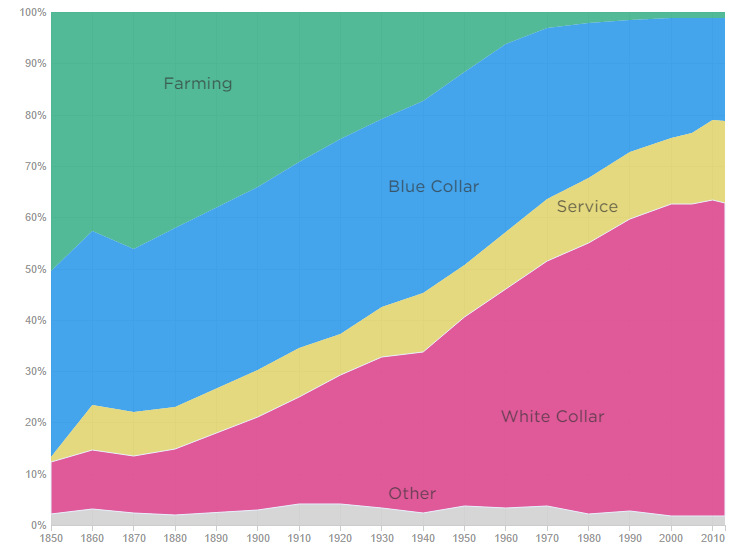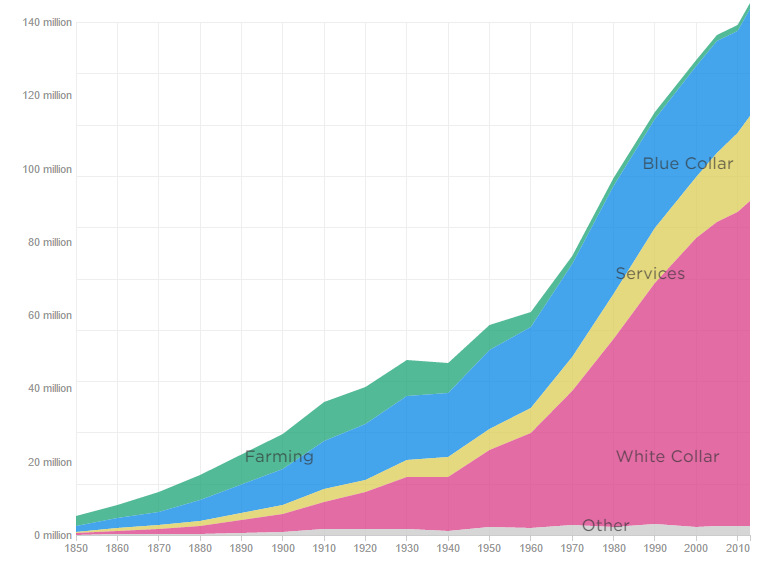Technology
How Machines Destroy and Create Jobs
“There’s just doesn’t seem to be many blacksmith jobs these days.”
At first glance, this would be a ridiculous thing to say. Of course there aren’t many blacksmiths around. We live in a modern society and machines do a way better job of making things from metal anyways.
However, it also raises an important point.
What if machines are better at driving long-haul trucks? What if machines are better servers at McDonald’s? What if robots did your taxes for you?
While some of these ideas are contentious today, in the future we may look back thinking that our fears were ill-placed. The truth is that the job landscape is constantly in flux as technology changes.
Some of today’s jobs with high automation potential may be the future “blacksmiths”, and we should not be surprised if they go away. The best thing that we can do is to understand these trends and build a set of skills that will be in demand in any market.
The Trend is Your Friend
The following graphics from NPR shows the evolution of jobs over time in the United States.
The first divides jobs into four main categories: white collar, blue collar, farming, and services. It shows how the composition of the overall job market has changed over the last 165 years:

The second shows the same information, but plotted by the total number of jobs:

There were 10 million farmers in America in the early 20th century.
Now there’s closer to one million, and yet those farmers produce way more food. Technology may have “killed off” the majority of farm jobs, but at the same time new technology created jobs in the service, blue collar, and white collar industries.
We may now be at a similar inflection point for other careers – this interactive graphic shows some of the jobs that have been on the decline in recent years.
In 1960, a whopping 11% of the workforce was employed in factories. Today only 4% are employed in factories.
In the late 1970s, almost 5% of the workforce was secretaries. Today, we’re at about half that, but professionals can be just as productive without a secretary thanks to better computer software.
Yes, there are globalization issues at play here as well, but even a modern domestic factory such as the Tesla Gigafactory (which has the largest building by footprint in the world) will only employ about 6,000 people. The majority of the work will be done by robots.
And while it seems scary to think about the rise of machines and a faster pace of technological advancement, it’s important to recognize that these types of sweeping changes to the job market have happened throughout history.
The point is, try not to be the 21st century version of a “blacksmith”.
Technology
All of the Grants Given by the U.S. CHIPS Act
Intel, TSMC, and more have received billions in subsidies from the U.S. CHIPS Act in 2024.

All of the Grants Given by the U.S. CHIPS Act
This was originally posted on our Voronoi app. Download the app for free on iOS or Android and discover incredible data-driven charts from a variety of trusted sources.
This visualization shows which companies are receiving grants from the U.S. CHIPS Act, as of April 25, 2024. The CHIPS Act is a federal statute signed into law by President Joe Biden that authorizes $280 billion in new funding to boost domestic research and manufacturing of semiconductors.
The grant amounts visualized in this graphic are intended to accelerate the production of semiconductor fabrication plants (fabs) across the United States.
Data and Company Highlights
The figures we used to create this graphic were collected from a variety of public news sources. The Semiconductor Industry Association (SIA) also maintains a tracker for CHIPS Act recipients, though at the time of writing it does not have the latest details for Micron.
| Company | Federal Grant Amount | Anticipated Investment From Company |
|---|---|---|
| 🇺🇸 Intel | $8,500,000,000 | $100,000,000,000 |
| 🇹🇼 TSMC | $6,600,000,000 | $65,000,000,000 |
| 🇰🇷 Samsung | $6,400,000,000 | $45,000,000,000 |
| 🇺🇸 Micron | $6,100,000,000 | $50,000,000,000 |
| 🇺🇸 GlobalFoundries | $1,500,000,000 | $12,000,000,000 |
| 🇺🇸 Microchip | $162,000,000 | N/A |
| 🇬🇧 BAE Systems | $35,000,000 | N/A |
BAE Systems was not included in the graphic due to size limitations
Intel’s Massive Plans
Intel is receiving the largest share of the pie, with $8.5 billion in grants (plus an additional $11 billion in government loans). This grant accounts for 22% of the CHIPS Act’s total subsidies for chip production.
From Intel’s side, the company is expected to invest $100 billion to construct new fabs in Arizona and Ohio, while modernizing and/or expanding existing fabs in Oregon and New Mexico. Intel could also claim another $25 billion in credits through the U.S. Treasury Department’s Investment Tax Credit.
TSMC Expands its U.S. Presence
TSMC, the world’s largest semiconductor foundry company, is receiving a hefty $6.6 billion to construct a new chip plant with three fabs in Arizona. The Taiwanese chipmaker is expected to invest $65 billion into the project.
The plant’s first fab will be up and running in the first half of 2025, leveraging 4 nm (nanometer) technology. According to TrendForce, the other fabs will produce chips on more advanced 3 nm and 2 nm processes.
The Latest Grant Goes to Micron
Micron, the only U.S.-based manufacturer of memory chips, is set to receive $6.1 billion in grants to support its plans of investing $50 billion through 2030. This investment will be used to construct new fabs in Idaho and New York.
-

 Energy1 week ago
Energy1 week agoThe World’s Biggest Nuclear Energy Producers
-

 Money2 weeks ago
Money2 weeks agoWhich States Have the Highest Minimum Wage in America?
-

 Technology2 weeks ago
Technology2 weeks agoRanked: Semiconductor Companies by Industry Revenue Share
-

 Markets2 weeks ago
Markets2 weeks agoRanked: The World’s Top Flight Routes, by Revenue
-

 Countries2 weeks ago
Countries2 weeks agoPopulation Projections: The World’s 6 Largest Countries in 2075
-

 Markets2 weeks ago
Markets2 weeks agoThe Top 10 States by Real GDP Growth in 2023
-

 Demographics2 weeks ago
Demographics2 weeks agoThe Smallest Gender Wage Gaps in OECD Countries
-

 United States2 weeks ago
United States2 weeks agoWhere U.S. Inflation Hit the Hardest in March 2024













